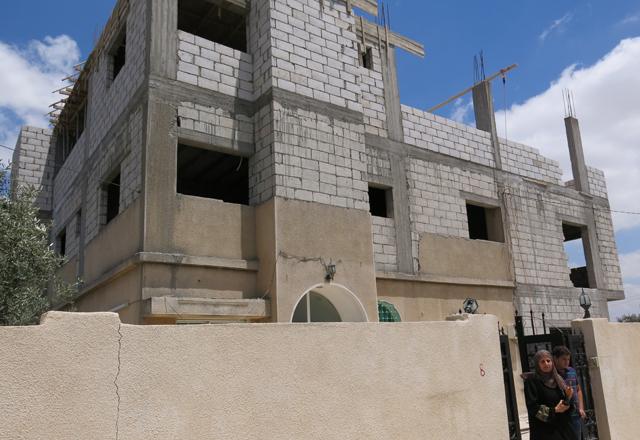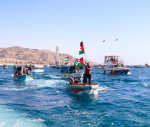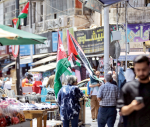You are here
Out-of-the-box housing solution helps both Syrian refugees and Jordanian hosts
By Elisa Oddone - Jul 10,2014 - Last updated at Jul 10,2014

IRBID — Hosting more than 600,000 Syrian refugees has put a strain on Jordan’s population, economy, services and scarce water supplies. But the Jordanian and Syrian communities have come together in the Kingdom, bracing for a crisis that still has no end in sight.
A daily average of 300 Syrians cross into Jordan, according to the UN High Commissioner for Refugees. Some of them have found refuge in the Kingdom’s two largest refugee camps, the newly opened Azraq Refugee Camp, some 100km east of Amman, and Zaatari, a few paces from the Syrian border.
The Azraq camp will eventually be able to accommodate up to 130,000 people, while Zaatari currently hosts around 100,000 residents, making it the Kingdom’s fourth largest population centre.
However, about two-thirds of the refugees reside in host communities scattered across Jordan, swarming in northern governorates close to the Syrian border, eking out a living to pay high rents, facing eviction threats and being prevented from working.
Life has also become harder for Jordanians. Price increases and lower quality of services have had deep repercussions on locals who, even before the start of the Syrian crisis in 2011, strived to make ends meet.
But since a trouble shared is a trouble halved, the two communities met halfway and joined a housing programme supported by the Norwegian Refugee Council (NRC), which both Syrians and Jordanians are benefitting from amid the ongoing crisis.
NRC programme
“Rent was increasing in Jordan as a result of the crisis and influx of Syrians,” NRC Country Director Robert Beer told The Jordan Times.
“We found that most of the responses from the different agencies in the host communities were a ‘cash for rent’ ones, providing refugees with money to afford rent. However, one of the dangers of this programme, very useful at first, is the effect upon the overall housing market,” Beer said.
With this concern in mind, NRC implemented a market intervention in one of the areas worse affected by the humanitarian crisis: trying to address the gap between housing supply and demand, the source of the rent increase.
Traditionally, Jordanians live in partially completed multistorey buildings. They invest in the construction of the upper storeys over a long period of time, as money is available, finishing construction ahead of the marriage of a male family member. Women usually move out of their birthplace upon marriage, joining their husbands and families in their own houses.
The NRC has been providing locals in the northwestern city of Irbid since November last year with financial aid to finish their properties, bringing them up to basic standard and eventually providing refugee families with houses.
“The investment we make in the completion of the construction equals a 12- or 18-month period rent,” Beer said. “We complete it in a way that it would provide a refugee family with an adequate shelter, with a toilet, bathroom and running water”.
Over 1,500 units have been completed so far in Irbid giving shelter to about 8,200 refugees.
“With this access to capital, presumably funds Jordanian landlords previously did not have, they were able to complete something that otherwise would have not been finished in the short term. In return, the refugee family would enjoy a period of free rent, as the rent is paid in advance with the money provided for the completion,” Beer said.
Local workers and materials are used to complete the house, thus the project also serves as an economic stimulator to the area affected by the large Syrian influx.
Available funding depends on the size, the situation of each property and the rent, spanning from JD1,000 for a one-bedroom apartment to JD5,600 for a four-bedroom unit.
The landlord can choose the rent period, either one year or one-and-a-half-year. The longer the period, the more funding is granted.
Each bedroom can accommodate up to five people; a four-bedroom flat could host up to 20 people.
“Before families move in, they would meet with the Jordanian landlords at least once. After meeting with the Syrian family, the landlords could refuse to host them if they find any issue they would not be comfortable with,” Beer said.
Potential multistorey buildings for the programme should be no more than 1.5-2km far away from the services any refugee needs, like shops, schools and hospitals. The property must have proper ventilation, show no deflection in the ceiling or mould on the walls.
Win-win situation
Landlady Nuha Sadiq Mhilan will host Syrians as soon as her two apartments in west Irbid are completed.
“We were stuck and not able to finish construction after our financial resources dried up. This project has in part saved us to move on to the next step and to finish the house,” Mhilan told The Jordan Times.
The mother of six received about JD4,000 in financial aid for each apartment, which will cover around 70 per cent of the overall expenses.
“I am very happy we will finish the apartment and will help Syrian families but, at the same time, I am a bit concerned because of the large number of people who will move in, but I am sure that if my family is welcoming towards them, they will be nice and cooperative in return,” Mhilan said.
“Syrians had to leave their homes and country and cross into Jordan. We must cooperate and be helpful with each other,” she added.
The project targets the most vulnerable Syrians living in host communities, Beer said, adding that people do not want to be refugees; they come to Jordan because they have to flee but do not want to live in refugee camps, which are always choices of last resort.
“Camps have a useful function as they are able to cover the basic need of people in displacement when they cannot afford to do so themselves — when they are in a situation where they are completely desperate and provide people with food, water, shelter, medicaments, education — but they are not places people choose to be.”
Under the threat of eviction in a city where average rent amounts to JD100 monthly and affected by a chronic disability, a Syrian from Daraa, who wanted to remain anonymous, waits to move in one of the newly completed house units.
He told The Jordan Times he had mostly borrowed money to make ends meet over the last year.
“I arrived in Jordan at the end of 2012. I lived in Zaatari for one month, then six months in Zarqa to finally relocate to Irbid. The environment in Zarqa was not good; the weather made my son fall sick due to the dust and the proximity to the petroleum refinery. The monthly rent was JD80 but the house’s conditions were very bad.”
He currently lives with his wife and five children, two of them having disabilities, in a one-bedroom apartment in Irbid, which costs JD100 monthly but the living room is of no use as it gets direct sunlight most of the day in a country where temperatures sometimes reach over 40ºC in summer.
“The rooms in the new house will provide privacy, unlike like this one. It will be on the ground floor, new and rent-free. We met the landlord over a cup of tea and got along very well. The children will be able to attend the nearby school in September and shops are a stone’s throw away from the house.”
Jordan is not in a post-emergency phase yet, according to Beer, as the humanitarian emergency is still ongoing.
“We have recently opened one of the largest refugee camps in the world but we absolutely must not forget the host community for the sake of both Jordanians and Syrians,” he said.
“At least, with this project, for every Syrian family that has been assisted, there is a Jordanian family that has been supported.”
Related Articles
By Mussa HattarAgence France-PresseIRBID — Struggling to make ends meet, Syrian refugee Umm Iman and her family spent years moving from hous
AMMAN — Nearly 5,600 housing units have been completed under a recently-concluded Norwegian Refugee Council (NRC) shelter project in Jerash,
The Norwegian Refugee Council (NRC) and UNICEF have begun providing “the first learning opportunities to vulnerable Syrian refugee children” at the Azraq Refugee Camp through an education programme launched this week.
















